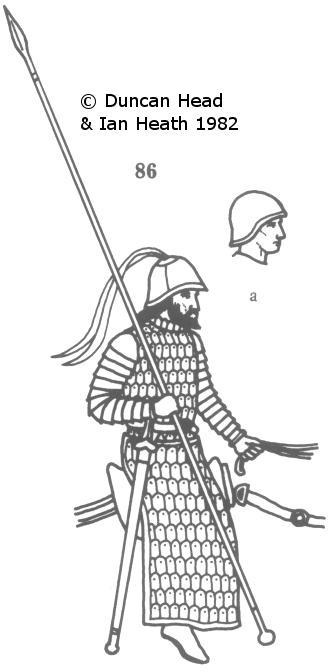
Try Amazon Audible Premium Plus and Get Up to Two Free Audiobooks

LATER SAKA ARMOURED CAVALRYMAN
An extract from Armies of the Macedonian and Punic Warsby Duncan Head, illustrated by Ian Heath
86. LATER SAKA ARMOURED CAVALRYMAN


This figure is in fact based on a coin of Azes, a 1st century BC Saka king in India, but the equipment of the last figure was replaced by heavier styles like this well before the end of our period. The long heavy lance, called kontos by the Greeks, was adopted in the 4th or 3rd century. At that time it appears in the graves of the Prokhorovka culture, which represents an intrusive eastern element, a branch of the Massagetai, living among and probably ruling, the eastern Sarmatians. The Massagetai may conceivably have copied the long spear from the xyston of the Macedonians, but dating of the graves is not sufficiently precise to tell whether the kontos was in use before the Macedonians arrived. Shortly before 200 BC the Seleucids adopted the complete cataphract panoply from the Parthians; their Saka neighbours and relatives will have been similarly equipped.
Azes’ defensive armour is similar to that of later Kushan cataphracts illustrated on frescoes from Khalchayan in Uzbekistan, not surprisingly since the Kushan replaced the Saka in India and neighbouring areas. I have used the Kushan example for details such as the collar of small upstanding lamellae, which seem to be indicated but not clearly shown on the coins. Azes wears what may be an ankle-length cuirass but is more likely a shorter cuirass and separate parapleuridia made of large lamellae - long narrow armour plates laced together. His arms are protected by the tubular segmented defences of figures 10 and 40. No bow or indeed any secondary weapon is shown; the Kushan figures similarly lack bows, and the arm defences may have been restrictive enough to make archery impractical. He would probably carry a long sword and/or sagaris.
A (probably early) Parthian terracotta in the British Museum shows a similar figure, with the helmet shown in 86a, thrusting underarm with his spear held in both hands. He too lacks a bow. Neither of these figures has horse armour, but since the Saka had it much earlier, and since the similar Kushan cavalry have horses fully protected with leather scales, it is safe to assume that at least some troops of this type would ride armoured horses.